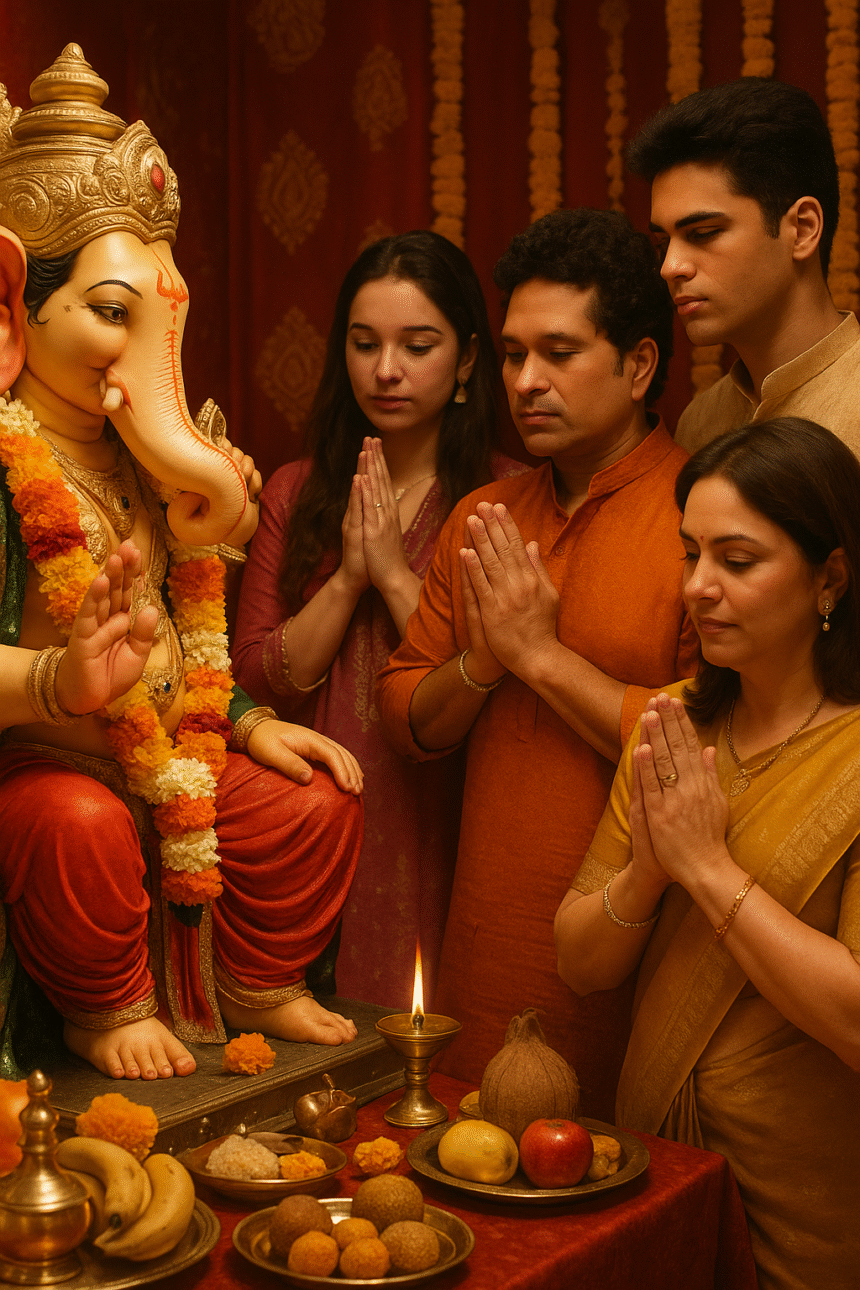analysisWe need to write article in HTML format, start with lead paragraph
etc. No
tag. Include 3-4 sections with
Background and Cultural Context
Ganesh Chaturthi, the nine‑day celebration of the elephant‑headed deity Lord Ganesha, draws millions to Mumbai each year. Lalbaugcha Raja, a historic pandal in the suburbs, is renowned for its intricate idol and the throngs of devotees that swarm it. In 2025, the festival’s popularity surged online: over 35 million combined views were recorded across Facebook, YouTube, and the official “Ishwar” app, making it one of India’s largest virtual religious gatherings.
For the Tendulkar household, the timing could not have been coincidental. Arjun Tendulkar, the 25‑year‑old son, announced his engagement to Saaniya Chandhok on August 13, a story that unfolded on Instagram Stories and a Reddit AMAs session hosted by the legendary batsman. Fans were stunned to see the family, dressed in traditional dhoti‑kurtas, step out of their homes, through a crowd of thousands, and into a bustling pandal that had been upgraded with smart sensors to gauge footfall and ensure crowd safety.
Key Developments: From Pandal to Platform
The family’s visit brought together centuries‑old custom with modern convenience. The location was fitted with Wi‑Fi boosters, 4G mesh points, and secure QR codes, every passable entry and exit route capped by helmeted ushers. The desired effect: a seamless flow of worshippers while enabling live‑streaming from high‑definition cameras placed all around the idol.
In addition to the 45‑minute live broadcast on YouTube, Facebook and the Tendulkar family’s personal Instagram account—where they shared a 5‑minute “darshan” clip—oversaw a latency‑free, 4K video feed that reached fans worldwide. The accompanying sound‑track, a remixed version of traditional Ganapati bappa bhajans by the acclaimed composer Neha Mukherjee, debuted on Spotify and Apple Music, blending classical ragas with a contemporary beat.
Further integrating technology, the pandal installed an AI‑powered crowd‑counting system that predicted peaks and routed fans to less congested entrances. Mobile applications displayed real‑time wait times and suggested optimal mounting times, ensuring that devotees, especially those with children or elderly relatives, had a comfortable experience. This approach has already sparked interest from other pilgrimage sites that are looking to modernize visitor engagement.
Impact Analysis: Why Students and International Visitors Care
While the event may seem purely celebratory, it highlights a growing trend: cultural tourism + tech. For students studying abroad or planning future educational journeys, the following points stand out:
- Digital Access to Heritage: The livestream and interactive maps mean that even if you cannot attend in person, you can still experience the ritual authentically.
- Safety Protocols: The AI crowd‑management and health‑monitoring systems set a new benchmark for safe public gatherings—a key consideration for international travelers during the ongoing post‑pandemic environment.
- Networking Opportunities: Social media engagement during the festival showcases the vibrant Indian diaspora and opens avenues for student exchange programs, internship placements, and cultural immersion trips.
- Documentation and Research: Academics can study the interplay of tradition and modern data analytics, extracting insights for broader socio‑cultural studies.
Moreover, the Tendulkar family’s adherence to tradition while embracing digital tools resonates with youth who crave authenticity yet expect instant connectivity. University portals frequently highlight such events to encourage global syllabus inclusion of Indian culture, thereby adding an international dimension to curriculum building.
Expert Insights and Practical Tips for Global Students
Dr. Maya Shah, a cultural anthropologist at the University of Mumbai, notes, “The Lalbaugcha Raja is a living laboratory for how heritage is repackaged for a digital era. Students who analyze the tech‑enabled visitor analytics can apply these frameworks to design culturally sensitive international travel advisories.”
For students chasing study‑abroad opportunities with a cultural slant, here are pragmatic recommendations:
- Identify Accessible Cultural Sites: Look for destinations that publish virtual tours or streaming options. This wealth of content helps you understand local customs before arrival.
- Leverage Augmented Reality Guides: Many India‑based universities partner with AR apps that overlay historical data onto physical sites. Download such guides to enrich your on‑site experience.
- Engage in Social Media Discussions: Follow hashtags and threads related to cultural festivals. Commenting or sharing thoughtful reflections can enhance your cultural literacy and networking visibility.
- Apply for ‘Cultural Exchange’ Grants: Governments and NGOs often fund projects that combine education with cultural immersion. Cite events like Ganesh Chaturthi’s tech integration as case studies in your proposal.
- Stay Updated on Visa and Health Protocols: With large crowds, air quality and sanitation advisories are vital. Use official app notifications rather than unverified word‑of‑mouth.
Looking Ahead: The Future of Cultural Tech Integration
According to recent studies from the Indian Ministry of Culture, 70% of students born after 2000 prefer content that merges tradition with technology. The Lalbaugcha Raja model could inspire similar initiatives:
- State‑backed “cultural‑tech hubs” that provide real‑time data to responsible civic authorities.
- Integration of blockchain for digital credence, such as verifiable “Blessing Certificates” issued to participants.
- Cross‑platform AI chatbots offering instant answers to pilgrims in multiple languages, including English, Marathi, Kannada, and Arabic.
As Ganesh Chaturthi 2026 approaches, the event organizers have said they plan to launch a virtual reality experience that allows remote users to “step inside” the pandal and interact with virtual pilgrims. For students planning to study or research in India, having this experience can be an invaluable preview of the cultural environment.
Reach out to us for personalized consultation based on your specific requirements.
